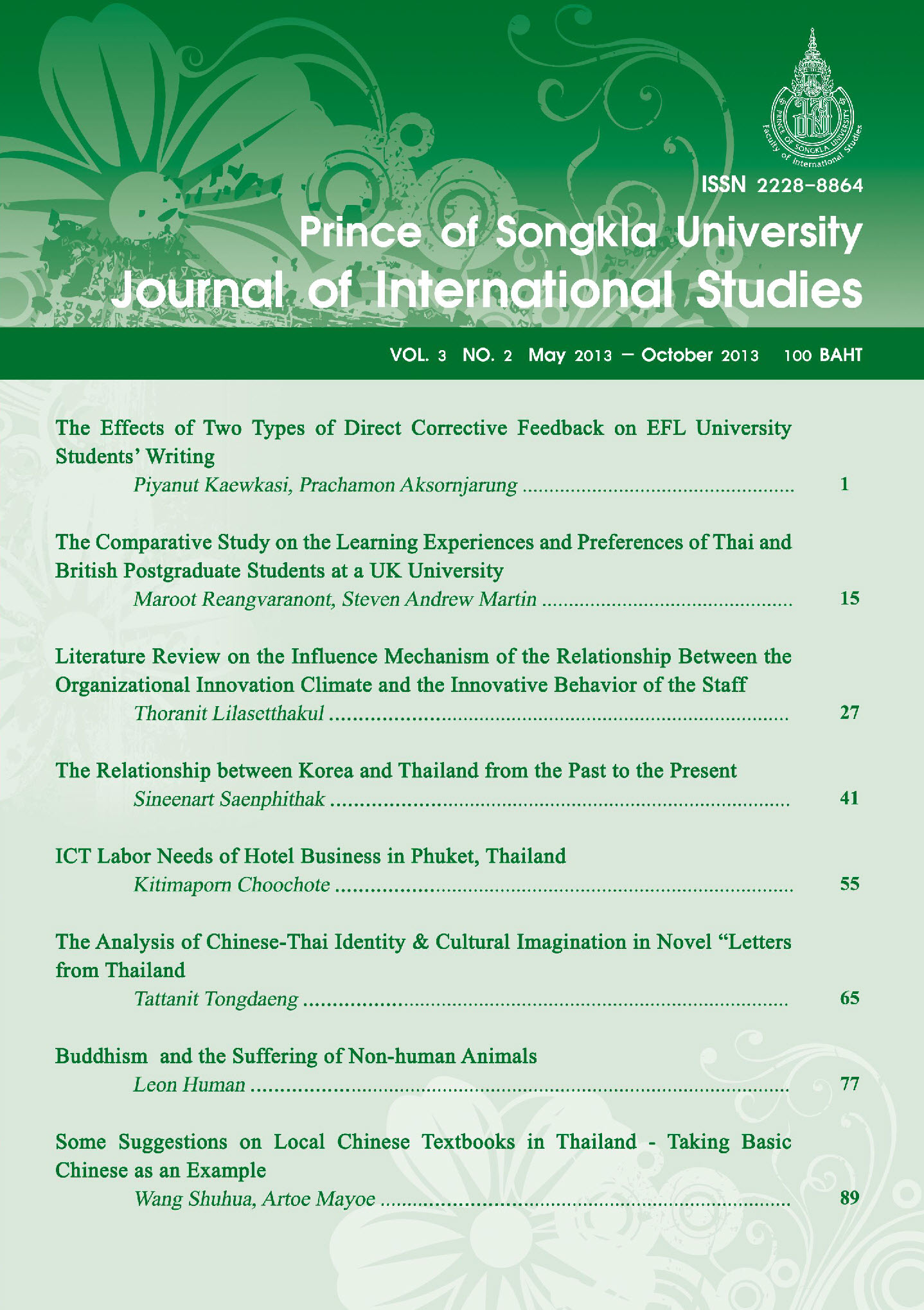ผลการให้ข้อมูลย้อนกลับแบบตรงสองประเภทในการเขียนของนักศึกษามหาวิทยาลัยที่เรียนภาษาอังกฤษเป็นภาษาต่างประเทศ
Main Article Content
บทคัดย่อ
การวิจัยนี้ศึกษาผลของการให้ข้อมูลย้อนกลับแบบตรงสองประเภทที่มีต่อการเขียนของผู้เรียน ชาวไทยที่เรียนภาษาอังกฤษเป็นภาษาต่างประเทศ กลุ่มตัวอย่างเป็นนักศึกษาหลักสูตรภาษาการสื่อสารและธุรกิจจํานวน 25 คน ซึ่งได้เข้าร่วมในการศึกษาแบบมีการทดสอบก่อนและหลังเรียน กลุ่มตัวอย่างเข้ารับการทดสอบก่อนเรียนการเขียนอนุเฉทเป็นระยะเวลา 13 สัปดาห์ ในระหว่าง การเรียนนักศึกษาได้รับมอบหมายให้เขียนอนุเฉทเป็นรายสัปดาห์ โดยกลุ่มตัวอย่างจํานวน 12 คน ได้รับข้อมูลย้อนกลับแบบตรงกับการให้คําอธิบายการใช้ภาษาแบบเขียน (Direct corrective feedback with written meta-linguistic explanation) และกลุ่มตัวอย่าง 13 คน ได้รับข้อมูลย้อนกลับแบบตรงกับการให้คําอธิบายการใช้ภาษาแบบวาจา (Direct corrective feedback with oral meta-linguistic explanation) หลังการเขียนงานแต่ละชิ้น มีการทดสอบหลังเรียนหลังการสอนครั้งสุดท้าย แล้วนําคะแนนที่ได้ก่อนและหลังเรียนมาวิเคราะห์ ทางสถิติเพื่อหาร้อยละของความถูกต้องของการใช้ไวยากรณ์ในเรื่อง อดีตกาลแบบปกติที่ลงท้ายด้วย -ed (regular past tense- -ed) และประโยคไม่สมบูณ์ (fragment) จากนั้นจึงนํา คะแนนความถูกต้องที่เป็นร้อยละไปเปรียบเทียบระหว่างกลุ่มผลการวิจัยแสดงให้เห็นว่าการให้ข้อมอ ย้อนกลับแบบตรงกับการให้คําอธิบายการใช้ภาษาแบบเขียนให้ผลเท่ากับการให้ข้อมลย้อนกลับ แบบตรงกับการให้คําอธิบายการใช้ภาษาแบบวาจาในการลดข้อผิดพลาดของไวยากรณ์ที่เป็นเป้าหมาย ทั้งสองเรื่อง
Article Details
ข้อความและความคิดเห็นที่แสดงในบทความ เป็นแนวคิดของผู้เขียน มิใช่ความรับผิดชอบของกองบรรณาธิการ และคณะผู้จัดทำแต่อย่างใด
บทความ ข้อมูล เนื้อหา รูปภาพ ฯลฯ ที่ได้รับการตีพิมพ์ในวารสารวิเทศศึกษา ถือเป็นลิขสิทธิ์ของวารสารวิเทศศึกษา หากบุคคลหรือหน่วยงานใดต้องการนำทั้งหมดหรือส่วนหนึ่งส่วนใดไปเผยแพร่ต่อหรือเพื่อกระทำการใด ๆ จะต้องได้รับอนุญาตเป็นลายลักษณ์อักษรจากวารสารวิเทศศึกษา ก่อนเท่านั้น
เอกสารอ้างอิง
Bitchener, J. (2008). Evidence in support of written corrective feedback. Journal of Second Language Writing. 17(2), 102-118.
Bitchener, J. & Knoch, U. (2008). The value of written corrective feedback for migrant and international students. Language Teaching Research Journal, 12 (3), 409-431.
Bitchener, J., & Knoch, Ute (2010). Raising the linguistic accuracy level of advanced L2 writers with written corrective feedback. Journal of Second Language Writing, 19, 207-217.
DeKeyser, R. M., (2009). Practice in a second language: perspective from applied linguistics and cognitive psychology. Cambridge: Cambridge University Press.
Doughty, C. & Williams, J. (1998). Focus on form in classroom second language acquisition. New York: Cambridge University Press.
Ellis, R., Sheen, Y., Murakami, M., &Takashima, H. (2008). The effects of focused and unfocused written corrective feedback in an English as a foreign language context. System, 36, 353-371.
Ferris, D. R., (1999). The case for grammar correction in L2 Writing classes. A response to Truscott (1996). Journal of Second Language Writing, 8, 1-10.
Ferris, D. R., (2002). Second language writing research and written corrective feedback in SLA: Intersections and practical applications (2010). Studies in Second Language Acquisition, 32, 181-201.
Heyer, S., (1989). Picture series for beginning communication. New Jersey: Prentice-Hall.
Hyland, F., (2003). Focusing on form: students' engagement with teacher's feedback, System, 31, 217-230.
Kepner, C. G. (1991). An experiment in the relationship of types of written feedback to the development of second- language writing skills. Modern Language Journal, 75, 305- 313.
Krashen, S.D. (1985). The input hypothesis: Issues and implications. Harlow: Longman.
Semke, H. (1984). The effect of the red pen, Language Annals, 17, 195-202.
Schmidt, R. (1993). Awareness and second language acquisition. Annual review of applied linguistics, 1992, 13, 206-226.
Sheppard, K. (1992). two feedback types: Do they make a difference? RELC Journal, 23, 103-110.
Sheen, Y. (2007). Differential effect of focused and unfocused written correction on the accurate use of grammatical forms by adult ESL learners, System, 37, 556-569.
Sheen, Y. Wright, D. Moldawa, A. (2009). Differential effects of focused and unfocused written correction on the accurate use of grammatical forms by adults ESL learners. System, 37, 556-569.
Sheen, Y. (2010a). Differential effect of focused and unfocused written correction on the accurate use of grammatical forms by adult ESL learners, System, 37, 556-569.
Sheen, Y. (2010b). Differential effect of oral and written corrective feedback in the ESL classroom. Studies in Second Language Acquisition, 32, 203-234.
Truscott, J. 1996. The case against grammar correction in L2 writing classes. Language Learning, 46, 327-369.
Truscott, J. 1999. The case for "the case against grammar correction in L2 writing classes": A Response to Ferris, Journal of Second Language Writing, 8, 111-122.


